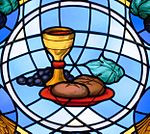
| Part of a series on the |
| Eucharist |
|---|
 |
Memorialism is the belief held by some Christian denominations that the elements of bread and wine (or juice) in the Eucharist (more often referred to as "the Lord's Supper" by memorialists) are purely symbolic representations of the body and blood of Jesus Christ, the feast being established only or primarily as a commemorative ceremony. The term comes from the Gospel of Luke 22:19: "Do this in remembrance of me", and the attendant interpretation that the Lord's Supper's chief purpose is to help the participant remember Jesus and his sacrifice on the Cross.
This viewpoint is commonly held by General Baptists,[1][2] Anabaptists,[3] the Plymouth Brethren,[3] segments of the Restoration Movement[3] (such as Jehovah's Witnesses),[4][5][6] and some Non-denominational Churches,[7] as well as those identifying with liberal Christianity.
It is rejected by other branches of Christianity, including the Roman Catholic Church, the Eastern Orthodox Church, the Oriental Orthodox Church, the Church of the East, the Methodist Churches, the Lutheran Churches, the Independent Catholic Churches, and the Reformed Churches (inclusive of the Continental Reformed, Anglican, Presbyterian, and Congregationalist traditions),[8][9][10] all of which variously affirm the doctrine of the real presence.[11][12]
- ^ "Basic Beliefs: Baptism & the Lord's Supper". Southern Baptist Convention. 2018. Archived from the original on 12 March 2013. Retrieved 5 January 2019.
The Lord's Supper is a symbolic act of obedience whereby members [...] memorialize the death of the Redeemer and anticipate His Second Coming.
- ^ "What We Believe: Baptism & the Lord's Supper". National Baptist Convention. 2018. Archived from the original on 7 August 2019. Retrieved 5 January 2019.
We believe the Scriptures teach that Christian baptism is the immersion in water of a believer, into the name of the Father, and Son, and Holy Ghost; to show forth in a solemn and beautiful emblem, our faith in the crucified, buried, and risen Savior, with its effect, in our death to sin and resurrection to a new life; that it is prerequisite [...] to the Lord's Supper, in which the members of the church, by the sacred use of bread and wine, are to commemorate together the dying love of Christ; preceded always by solemn self-examination.
- ^ a b c Balmer, Randall Herbert; Winner, Lauren F. (2002). Protestantism in America. New York: Columbia University Press. p. 26. ISBN 9780231111300.
- ^ "The Lord's Evening Meal: An Observance That Honors God". What Does The Bible Really Teach?. Watch Tower Bible and Tract Society of Pennsylvania. 2014 [2005]. pp. 206–208. Retrieved 18 July 2020.
- ^ "The Lord's Supper: Why Do Jehovah's Witnesses Observe the Lord's Supper Differently From the Way Other Religions Do?". Watchtower Online Library. Watch Tower Bible and Tract Society of Pennsylvania. 2018. Retrieved 18 July 2020.
- ^ "The Eucharist: The Facts Behind the Ritual". The Watchtower. Watch Tower Bible and Tract Society of Pennsylvania. 1 April 2008. pp. 26–29. Retrieved 18 July 2020 – via Watchtower Online Library.
- ^ "University of Virginia Library". Religiousmovements.lib.virginia.edu. 2006-09-07. Archived from the original on 2007-10-30. Retrieved 2010-07-29.
- ^ McKim, Donald K. (1998). Major Themes in the Reformed Tradition. Wipf and Stock Publishers. ISBN 978-1-57910-104-6.
The Westminster Confession emphatically declares that Christ is truly present in the elements and is truly received by those partaking, "yet not carnally and corporally, but spiritually" (chap. 31, par. 7). The insistence is that while Christ's presence is not physical in nature it is no less a real and vital presence, as if it were a physical presence. ... Those of us in the Reformed tradition are under strong obligation to honour the notion of the real presence of Christ in the Lord's Supper.
- ^ Garvie, Alfred Ernest (1920). The Holy Catholic Church from the Congregational Point of View, namely, the One Church in the Many Churches. London: Faith Press.
He is really present at the Lord's Supper without any such limitation to the element unless we are prepared to maintain that the material is more real than the spiritual. It is the whole Christ who presents Himself to faith, so that the believer has communion with Him.
- ^ Rogers, Jack (1985). Presbyterian Creeds: A Guide to the Book of Confessions. Westminster John Knox Press. p. 115. ISBN 978-0-664-25496-4.
As whole persons we encounter the real, spiritual presence of Christ.
- ^ Neal, Gregory S. (19 December 2014). Sacramental Theology and the Christian Life. WestBow Press. p. 111. ISBN 9781490860077.
For Anglicans and Methodists the reality of the presence of Jesus as received through the sacramental elements is not in question. Real presence is simply accepted as being true, its mysterious nature being affirmed and even lauded in official statements like This Holy Mystery: A United Methodist Understanding of Holy Communion.
- ^ Losch, Richard R. (1 May 2002). A Guide to World Religions and Christian Traditions. Wm. B. Eerdmans Publishing. p. 90. ISBN 9780802805218.
In the Roman Catholic Church the official explanation of how Christ is present is called transubstantiation. This is simply an explanation of how, not a statement that, he is present. Anglicans and Orthodox do not attempt to define how, but simply accept the mystery of his presence.
© MMXXIII Rich X Search. We shall prevail. All rights reserved. Rich X Search
